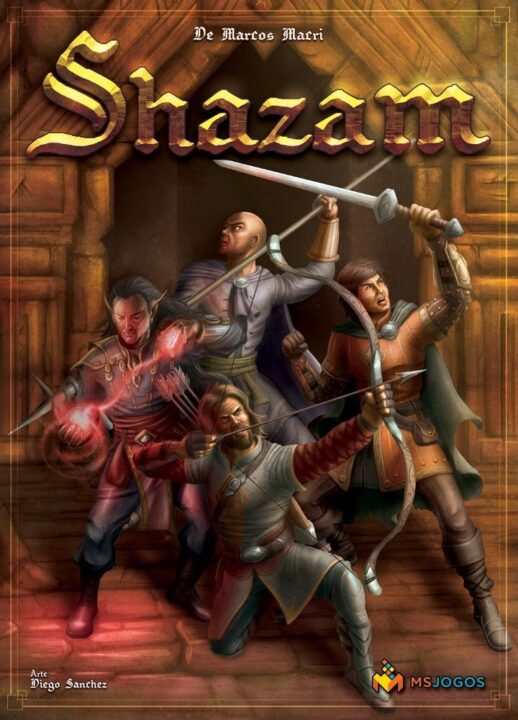Welcome to my review of Shazam! If you’ve ever wanted to sling spells at your friends while laughing at their terrible magic puns, grab a seat. I wrangled my trusty gaming crew, shuffled up the decks, and got zapped more than I care to admit. But was it pure fun, or did it fizzle out faster than a soggy sparkler? Let’s see if this party game conjures up true magic, or if it leaves us wishing for a better spellbook.
How It Plays
Setting Up
First, lay out the main board of Shazam and slap those spell cards in a neat pile. Hand each player their wizard meeple and matching tokens. Everyone grabs a handy spell sheet (don’t panic, there’s no ancient language—just fun icons). Place some magic crystals in the center. Boom, you’re set.
Gameplay
On your turn, pick a spell from your sheet and try to cast it using your cards and tokens. Sometimes you’ll chant silly words (yes, my friends made me say “Boogledy-boo” out loud), sometimes you collect crystals, sometimes you mess with another player’s plans. Turns bounce around fast. You have to keep one eye on your own plan and the other on what the sneaky folks beside you are doing. Every spell has a cost, so gather the right stuff before you cast, or risk feeling like a magic school dropout.
Winning the Game
The first wizard to hit the magic point total (it’s written right on the board, so no need to guess) wins and gets to do the victory dance. That’s it. Quick, competitive, and full of shouty moments and laughs.
Want to know more? Read our extensive strategy guide for Shazam.
Shazam’s Gameplay Mechanics & Player Interaction: Where Chaos and Strategy Collide
When I first plopped the Shazam box down on the table, my friends eyed it like it might suddenly start chanting a spell. But the only magic here is in its gameplay mechanics—if you call unpredictable moves and sudden reversals of fortune magic (I call them “Mike steals my win again”).
Shazam is part memory, part bluff, and part “how did that even happen.” Each round, you have to play cards that either help or hinder someone, but not in the way you expect. I love when a game lets you interfere with others, but not so much when a random card flips the whole table. Still, there’s a lot to be said for laughing at your misfortune with friends. The tension builds as more cards hit the table, and you can almost hear the groans and cheers as alliances crumble faster than my resolve at a board game sale.
What I noticed (and maybe hated a little) is that luck sometimes decides who gets the upper hand. There’s plenty of room for clever plays, but just as often, your fate gets decided by the next person who draws a card called “Zap!” and ruins your plans. That can cause grumbling amongst the more competitive players (I’m looking at you, Sarah), but it also means games move fast and nobody gets stuck in analysis paralysis.
Still, player interaction is strong—you can’t win by ignoring the table. You have to watch your buddies, predict their moves, and try to outwit them (if you can). If you think board games should be about making enemies out of your closest friends, Shazam’s got you covered.
Next, let’s put on our artist’s beret and see if the theme and artwork of Shazam dazzle or fizzle!
Theme and Artwork: Shazam’s Magical Makeover
If there’s one thing Shazam gets right, it’s turning your tabletop into a spell-slinging spectacular. I’m talking magical books, goofy hats, and wands that look like they’re straight from a fire sale at the wizard outlet. The theme isn’t just slapped on like ketchup on fries—it’s baked right in. From the card names (“Bumble Hex”? Yes, please) to the zany spell effects, you end up feeling like you’re actually at a wizarding dueling club. I half-expected my dog to turn into a toad midway through round two. Didn’t happen, but a guy can dream.
The artwork is a treat. If you like your games with color, Shazam will make you feel like you dropped your game shelf in a vat of rainbow paint. Each card features lively, cartoonish illustrations that manage to be whimsical without crossing into “I-just-ate-too-much-candy” territory. Even my friend Dave (known art snob—he once criticized Tic-Tac-Toe for weak visual direction) was impressed. The game board pops, the tokens sparkle, and the spell cards have enough detail to keep folks pointing and giggling. “Is that a frog in a tutu?” someone asked. Why, yes, yes it is.
For theme lovers, this one’s a no-brainer—the fun factor is strong, and the visuals keep things up-tempo. Even the rulebook is peppered with jokes and little illustrations, which made setup surprisingly less of a slog. Shazam’s magical theme and lively artwork are definitely some of its biggest selling points. If you want eye candy and giggles, you’ll find them here in spades.
But is all that flash and dazzle balanced when it comes to luck and skill? Grab your wizard hat; we’re about to cast the truth spell in the next section!
Magic or Mayhem? The Balance of Skill vs. Luck in Shazam
Let’s get something straight: Shazam will not let you coast through on rabbit’s-foot luck alone. As much as I tried to just rub my dice and chant ‘abracadabra,’ the game’s clever mechanics forced me to actually use my noggin. You can’t just win because you drew a lucky card—success in Shazam comes from timing, smart spell choices, and reading the other players better than your cousin can read minds (and trust me, I have a cousin who claims she can talk to squirrels; she was completely flummoxed by Shazam).
That’s not to say good fortune never shows up. Sometimes, a hasty hex or surprise twist can throw your plans out the window, kind of like when I tried to hide the snacks from my friends. But for the most part, the game rewards thinking ahead and adapting to the ever-changing magical mayhem on the board. Players who pay attention, predict what’s coming, and manage their resources wisely usually come out on top. In our group, my friend Carl tried to wing it every time, and, well, let’s just say he ended up the magical equivalent of a soggy sandwich.
Still, Shazam finds a decent balance. It’s not chess, but it’s not Snakes and Ladders either. There’s just enough uncertainty to keep things tense, but skillful play is what gets you the trophy (or at least bragging rights until the next pizza delivery).
Now, if you want to know whether Shazam keeps its spell after multiple plays or fizzles out, stick around—next up, I’m talking replay value and how long you’ll actually want to keep playing before turning into a pumpkin.
How Often Can You Yell “Shazam” Before It Gets Old?
Alright, let’s talk about replay value and how long a game of Shazam takes. Because if I’m going to drag my friends to another magical showdown, I want to know if I’m in for a marathon or a sprint.
Shazam is a board game that doesn’t wear out its welcome, unless you’ve got that friend who takes forever to make a move (we all know someone like that, right?). Most sessions with my group hovered around 30-40 minutes. That sweet spot meant we could play more than once in a night, or squeeze a round in before everyone had to catch the last train home. No one felt like they’d lost an entire evening to it, and no one fell asleep at the table either.
Now, replay value. Here, Shazam surprised me. Every play felt a little different. The mix of spells and clever actions means no two games played out the same way. You can try new tricks every time you play, and there’s always the fun of messing with your friends’ plans. As long as you swap up the group and don’t play five times in a row, it stays fresh. If you burn through it too often, you might spot some familiar combos and start getting cocky, but hey, that’s part of the charm!
If you want a snappy, replayable game, I do recommend grabbing Shazam. But, if you want a lifestyle game you never get bored of, maybe keep looking. Magic is best in small, joyful doses!
Conclusion
Alright, that wraps up my wild wizard trip with Shazam! This game really brings the magic when it comes to player interaction, colorful art, and replay value. If you love casting spells and laughing with friends, it’s a fun pick. Lucky rolls don’t run the show here—skill actually matters, so your cleverness can shine for once (sorry, Steve). Still, it won’t suit folks who want endless depth or epic game nights, since it’s best in shorter bursts. Overall, I’d hand it a solid 4 out of 5. Give it a shot if you’re after magical mayhem, but maybe keep Dungeons & Dragons on the shelf for meatier nights. Thanks for joining me on this mystical ride—review over, you may now put your wands down!


